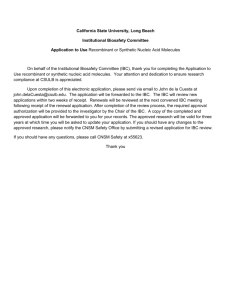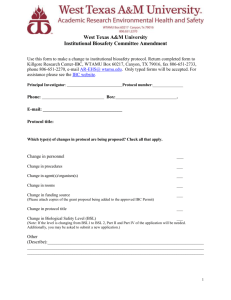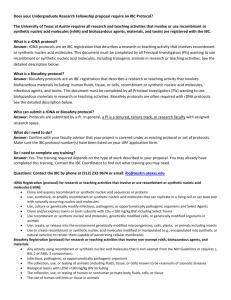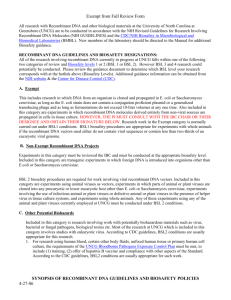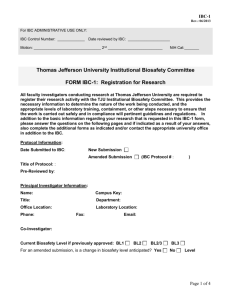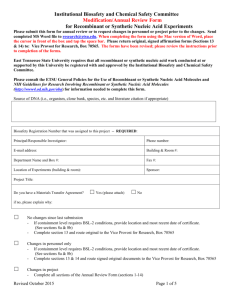Request Form for the Evaluation of Biological and Chemical Safety
advertisement
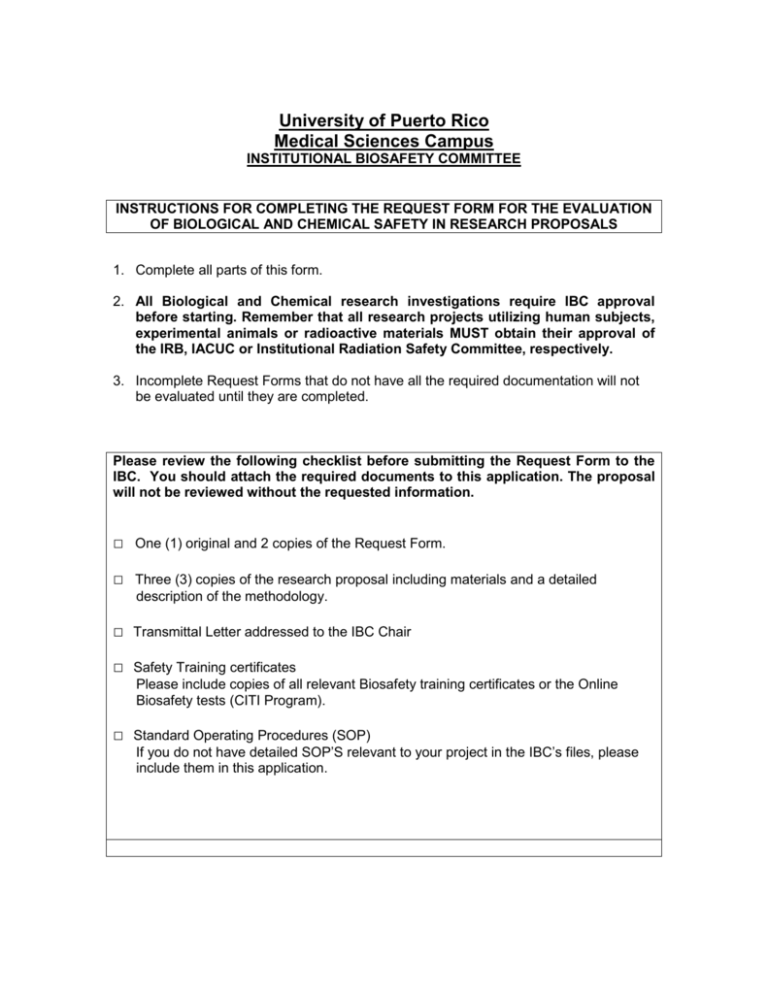
University of Puerto Rico Medical Sciences Campus INSTITUTIONAL BIOSAFETY COMMITTEE INSTRUCTIONS FOR COMPLETING THE REQUEST FORM FOR THE EVALUATION OF BIOLOGICAL AND CHEMICAL SAFETY IN RESEARCH PROPOSALS 1. Complete all parts of this form. 2. All Biological and Chemical research investigations require IBC approval before starting. Remember that all research projects utilizing human subjects, experimental animals or radioactive materials MUST obtain their approval of the IRB, IACUC or Institutional Radiation Safety Committee, respectively. 3. Incomplete Request Forms that do not have all the required documentation will not be evaluated until they are completed. Please review the following checklist before submitting the Request Form to the IBC. You should attach the required documents to this application. The proposal will not be reviewed without the requested information. □ One (1) original and 2 copies of the Request Form. □ Three (3) copies of the research proposal including materials and a detailed description of the methodology. □ Transmittal Letter addressed to the IBC Chair □ Safety Training certificates Please include copies of all relevant Biosafety training certificates or the Online Biosafety tests (CITI Program). □ Standard Operating Procedures (SOP) If you do not have detailed SOP’S relevant to your project in the IBC’s files, please include them in this application. University of Puerto Rico Medical Sciences Campus Institutional Biosafety Committee IBC approved______ University of Puerto Rico, MSC From______ to______ __________________ IBC Chairperson FOR NEW PROPOSALS REQUEST FORM FOR THE EVALUATION OF BIOLOGICAL AND CHEMICAL SAFETY IN LABORATORY PROJECTS Instructions: Submit this form in conjunction with research proposals of projects dealing with: - Infectious Agents Use of Hazardous Chemicals Use of Human or Animal Blood, Body Fluids, Cell Lines or Tissues Use of Non-Exempt Recombinant or Synthetic Nucleic Acid Molecules* Investigator’s name: (Last, First, MI) School School of Medicine PI’s E-mail Address Department Office Num. Telephone Number Proposal Title Funding Agency Proposed Start Date (MM/DD/YY) Proposed End Date (MM/DD/YY) Location of Work (List Building (s) and Room Number (s)) Lab Supervisor or Key Senior Personnel (to Answer Questions in PI’s Absence) Is this a new project or an amendment to an existing project? Updated: May 2015 New Write a brief overview of the project and its goals. This description needs to be understood by scientists outside your field and lay persons that are members of the committee. Include a detailed description of the methodology. Please answer all of the following: 1. Will this project utilize infectious agents (excluding hosts for Recombinant or Synthetic Nucleic Acid Molecules)? Yes No If ‘Yes, complete Section A- (Use of Infectious Agents) , Section E (Safety Training) and Section F ( Procedures in Case of Accidents) 2. Will this project utilize hazardous chemicals (carcinogens, teratogens), or other toxic chemical agents? Yes No If ‘Yes’, complete Section B- (Use of Hazardous Chemicals) , Section E- (Safety Training) and Section F (Procedures in Case of Accidents) 3. Will this project utilize human or animal blood, body fluids, cell lines or tissues? Yes No If ‘Yes’, complete Section C- (Use of Human or Animal Blood, Body Fluids, Cell Lines or Tissues) , Section E- (Safety Training ) and Section F (Procedures in Case of Accidents) 4. Will this project involve Non-Exempt Recombinant or Synthetic Nucleic Acid Molecules? Yes No If ‘Yes,’ complete Section D- (Use of Non-Exempt Recombinant or Synthetic Nucleic Acid Molecules*), Section E- (Safety Training) and Section F (Procedures in Case of Accidents) It is your responsibility to classify your work correctly. If you are unsure whether your research is exempt or not, please do not hesitate to contact the Compliance Office and consult the NIH Guidelines for Research Involving Recombinant or Synthetic Nucleic Acid Molecules at: http://osp.od.nih.gov/office-biotechnology-activities/biosafety/nih-guidelines 5. Are detailed Standard Operating Procedures (SOP’s) relevant to this project in the files of the Institutional Biosafety Committee (IBC)? Yes No A) If ‘No’ please submit all relevant SOP’s with this proposal B) If ‘Yes’, does this proposal require new SOP’s? Yes No C) If new SOP’s are needed, please list them below and provide copies of them in this application. Updated: May 2015 Section A- Use of Infectious Agents Provide the following information for all agents that you will use in this project. Note: It is your responsibility to ensure that work with the agent is conducted in accordance to the biosafety level for which you are approved to use that agent. Reminder: If your project involves the use of laboratory animals, human subjects or radioisotopes, you must also obtain approval from the Institutional Animal Care and Use Committee (IACUC), the Institutional Review Board (IRB) and the Radiation Safety Committee (RSC), respectively. Name of Agent 1. 2. Strains Used in Vitro? Enter Biosafety level BSL BSL N/A (Non applicable) N/A (Non applicable) BSL N/A (Non applicable) 3. Used in Vivo? Enter Species and Biosafety level BSL BSL N/A (Non applicable) BSL N/A (Non applicable) N/A (Non applicable) 4. BSL N/A (Non applicable) 5. BSL N/A (Non applicable) 6. BSL N/A (Non applicable) 7. BSL N/A (Non applicable) 8. BSL N/A (Non applicable) 9. BSL N/A (Non applicable) 10. BSL N/A (Non applicable) Updated: May 2015 BSL N/A (Non applicable) BSL N/A (Non applicable) BSL N/A (Non applicable) BSL N/A (non applicable) BSL N/A (Non applicable) BSL N/A (Non applicable) BSL N/A (Non applicable) Describe safety measures to be used when handling the infectious agents listed on the previous table. Describe the method of decontamination and disposal of the waste generated from the use of the agents listed above. (Gloves, plastic ware, materials, fluids, etc.) Section B- Use of Hazardous Chemicals Categories of Hazardous Chemicals: 1. Hazardous Chemicals (including heavy metals) 2. Flammable/explosive/corrosive chemicals 3. Carcinogenic/mutagenic/teratogenic chemicals 4. Acetyl cholinesterase inhibitors/neurotoxins 5. Controlled substances (refer to http://www.dea.gov/concern/concern.htm) Chemical List Name of Chemical Category Number *PPE **SES ***SEH Decontamination and Disposal Method *Personnel Protection Equipment= includes gloves, respiratory protection, eye protection, etc. **Safety Equipment for Storage: Location= cabinets for chemicals and/or flammables, safety box for controlled substances, etc. ***Safety Equipment for Handling: Location= chemical/fume hoods. ●Corresponds to any of the category numbers (1-5) of the hazardous chemicals described above. Updated: May 2015 Section C- Use of Human or Animal Blood, Body Fluids, Cell Lines or Tissues Describe in the space provided below the sources of blood, body fluids, cell lines or tissues to be used in your project and any information relevant to determining its infectious or otherwise hazardous potential. Reminder: In many cases, use of human- origin material also requires approval of the Institutional Review Board. Use of animal material also requires IACUC approval. Have these materials been tested for infectious agents prior to use in your laboratory? Yes No If no, describe how these infectious agents are going to be treated and their safety precautions Describe the methods for decontamination and disposal of the waste generated from the use of the materials listed above. (Gloves, plastic ware, materials, fluids, etc.) Enter the names of all personnel that will be handling the human-origin material and whether they have received vaccination for Hepatitis B virus, and if that personnel have taken the required course about blood-borne pathogens. The University of Puerto Rico Medical Sciences Campus policy is that all such personnel must take the required course about blood-borne pathogens and be offered immunization against hepatitis B virus. Submit evidence for both. Name Blood-Borne Pathogens Course Hepatitis B Virus Vaccination N/A N/A N/A N/A N/A N/A N/A N/A N/A N/A N/A N/A N/A N/A N/A N/A Section D- Use of Non-Exempt Recombinant or Synthetic Nucleic Acid Molecules* Provide a brief description of the Non-Exempt Recombinant or Synthetic Nucleic Acid work to be conducted for this project. Is the proposed work exempt under the NIH Guidelines for research involving recombinant or synthetic nucleic acid? Yes No If Yes, explain which exceptions of the NIH guidelines applies to your research work. If No, complete the information in this section. Please provide the following information on the use of Non-Exempt Recombinant or Synthetic Nucleic Acid: Source(s) of DNA or Recombinant or Synthetic Nucleic Acid Vector(s) Host(s) for propagation Name of protein(s) to be expressed (enter “none” if not applicable) Is the expressed protein toxic to vertebrates? (Enter NO if not applicable) Yes No Does recombinant contain 2/3rds of a viral genome? If no, explain why. Updated: May 2015 Yes No Which of the following will serve as hosts for the Non-Exempt Recombinant or Synthetic Nucleic Acid Molecules? (Enter animal or plants species and population of humans if appropriate) Cultured Cells: Animals: Whole Plants: Humans: Other: *For definition of Non-Exempt Recombinant or Synthetic Nucleic Acid Molecules: http://osp.od.nih.gov/office-biotechnology-activities/biosafety/nih-guidelines NIH Guidelines for Research Involving Non-Exempt Recombinant or Synthetic Nucleic Acid Molecules. Describe the methods for the decontamination and disposal of the waste generated from the use of the potentially hazardous materials/agents listed above. (Gloves, plastic ware, materials, fluids, etc.) Section E- Safety Training Describe how personnel have been trained in the handling of the following: NonExempt Recombinant or Synthetic Nucleic Acid Molecules, infectious agents, biological toxins, chemical toxicants, human or animal blood components, body fluids and tissues, when applicable. Updated: May 2015 Indicate the name of the personnel that will participate in this project and their training dates. For training of personnel, courses are routinely offered by the MSC/UPR Office for the Safety in Research Laboratories. Provide a copy of the training certificates and/or test and date taken, with this form. Provide evidence for the Biosafety training, which is due every 3 years. Provide evidence for the Biomedical Waste training (if necessary), which must be taken annually. Name of personnel Biosafety Training Date Biomedical Waste Training Date (if necessary). Section F- Procedures in case of Accidents Describe the procedures that will be performed in the event an employee, student or co-worker becomes ill, is accidentally exposed, and/or exhibits symptoms and signs consistent with exposure to any hazardous agents described in this form. Include all emergency phone numbers. ASSURANCE I agree to fully comply with the policies and procedures established by the University of Puerto Rico Medical Sciences Campus as well as all applicable rules and regulations. I certify that all personnel involved in this project have been trained in all applicable safety procedures and has been made aware of all risks involved in this project. The information provided is accurate and complete. __________________________________ Investigator’s Signature Updated: May 2015 Date
